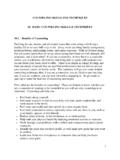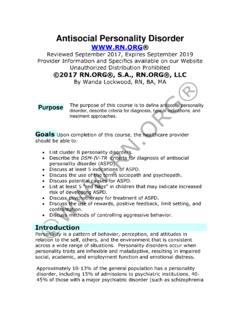Transcription of Building Your Resilience To Handle Difficult Clients
1 Building your Resilience To Handle Difficult Clients In turbulent times, the need to build Resilience in handling Difficult customers is greater than ever. How you choose to Handle those customers can make all the difference between creating a satisfied customer versus the scenario in which the customer walks away angry or upset. While you cannot control another person's attitude or behaviours, it is important to remember that you can control your own. How you approach the challenge of serving Difficult customers can make all the difference in your own attitude and perspective. When service breaks down for a customer, he or she deals with frustration and dissatisfaction in a variety of ways. Often, employees are in the firing line of his or her anger or irritation. Customers come to us angry for a variety of reasons, many of which we cannot affect. There are effective strategies we can use to help manage the situation. Let us examine different types of Difficult customers and learn what kinds of tactics are most effective for diffusing their frustrations and negative behaviours.
2 The hostile-aggressive customer The most intimidating type of customer to deal with is the one who yells or screams at employees. I call this type of person the hostile-aggressive customer and engaging this person can be quite uncomfortable for an employee as the following story illustrates. When Mayl arrived at the company office one morning, the day had started off quite well. The kids had gotten up on time, no one missed the bus, and the drive to work was smooth and trouble-free. May recently had started in the customer service department and enjoyed her work. She spoke with a variety of customers on the phone every day, and kept learning new aspects of his job as she solved their problems and answered their questions. However, today would be different. Sam was a recent transferee into town and company had moved his family's household goods into their new home last week. Now, at on a Monday morning, Sam had done a bone to pick with organization May was right in his line of fire.
3 As she adjusted his headset, the incoming call button on her phone flashed and May punched the button to get the day started. She had barely greeted the caller when an angry voice boomed into his earphones. "What in the world is wrong with you people!" Sam screamed. "Are all of you as incompetent as those idiots who moved our stuff in last week?". Copyright @ Continuum Learning Pte Ltd. All Rights Reserved Version 2010. 1. May gulped and took a deep breath. "Sir, I'm sorry. What seems to have been the concern?" For the next five minutes, May endured an expletive-filled rant from Sam. May was so uncomfortable and taken aback that she could barely get a word in edgewise - and when she did, all he could get out was apologies, which seemed to make Sam even madder. May was finally able to get Sam's name, pull up his record in the computer, and ask a few questions. It turned out the movers had broken a box of the Sam family's good china, and while that was bad enough, it was the lack of remorse displayed by the movers that really had raised the family's collective blood pressure.
4 The outburst of anger threw May for a loop, and he could not seem to get back control of the conversation. Sam's threats to report the service lapse to his corporate relocation department sent chills down May's back. She knew it was important to satisfy Sam so the company did not receive a negative review from the corporate client - but she could not get Sam to slow down enough to listen to her options. When Sam ultimately slammed down the phone in May's ear, all the pleasure had drained out of May's day and her stomach was in knots. Suddenly, the prospect of spending several years with the organization seemed far less appealing than it had at the beginning of the day. She was emotionally drained and unsure where to turn to learn how to Handle the next Sam more effectively. Hostile-aggressive customers are experts at taking their hurt and disappointment out on others. They seem unable to manage their anger and frustration internally and instead, use other people as human punching bags.
5 They usually stick to verbal assaults but occasionally, will resort to physical threats like pounding on the table or pointing a finger in someone's face. Few employees look forward to dealing with them. In their anger, hostile-aggressive customers often fail to listen and may make threats to "report you to authorities" or "take my business somewhere else". They often lose sight of their goal - which is to solve a problem. Dealing with them is emotionally and physically draining. Increasingly, after letting off steam, hostile-aggressive customers often calm down and even feel guilty or embarrassed about their behaviour. When it comes to coping strategies, the goal when dealing with hostile-aggressive customers is to try and defuse their anger while moving toward problem-solving. At no point should you let the customer physically threaten you. Every business needs contingency plans for responding to physical aggression by customers, no matter how uncomfortable it might seem in the planning process.
6 Thankfully, the vast majority of hostile-aggressive customers do not resort to physical violence but they still can make employees very uncomfortable with their attitude, behaviour and language. Copyright @ Continuum Learning Pte Ltd. All Rights Reserved Version 2010. 2. Some strategies for defusing their anger include: * Do not take their anger personally. Remaining calm and unemotional will help de-escalate the conflict. * Know your own limits. Some people are not bothered by cursing and expletives - others find that behaviour unacceptable. Know where you draw the line and be willing to hang up or walk away from the customer at that point. While we like to think that "the customer is always right", it does not mean the customer has the right to curse and swear at you. * Let the customer know you have reached your limits by saying something to the effect of, "Mr Sam Tan, I'd very much like to help you. I can't solve your problem if you're going to swear at me." If that does not stop the cursing (or other hostile behaviour), you can say something such as, "I'm going to have to terminate this call if your swearing doesn't stop.
7 You're welcome to call us back after you have calmed down.". * Keep your voice and gestures neutral. If you let yourself become angry or emotional, that will prolong the situation. your calmness can help defuse the customer's anger. * Sometimes, hostile-aggressive customers just want to blow off steam. If you do not feel threatened by their behaviour, actively listening to them can help. Ask questions to help them give you the details. It is a similar approach to dealing with angry children or lancing an infected wound. By "letting it out", you help them let go of their immediate anger. * Focus on facts, not emotion. Work to uncover the facts of the situation and take notes. This helps you avoid asking them to repeat what already has been said - something bound to raise the blood pressure of the hostile-aggressive customer. * Use empathy in measured amounts. "I understand that you are upset because of the .". * Let them know you want to solve their issues promptly and accurately, and ask for their cooperation.
8 "Mr Sam Tan, I'm going to get to the bottom of this situation - May you please help me do that by telling me what steps you've already taken to resolve this issue?". Copyright @ Continuum Learning Pte Ltd. All Rights Reserved Version 2010. 3. * Tone of voice and attitude are everything. If you do not care or you think the customer is "blowing things out of proportion", that will come across in your conversation with the customer. What you say often matters less than how you say it. * If you do in fact feel physically threatened or in danger, call someone in security or with the authority to help you. There is no reason you should put up with feeling helpless or in jeopardy. Managers need to ensure that policies and procedures are in place that provide employees with the support and security they need to do their jobs effectively. Please be aware that different people have different levels of sensitivity; take time to find out your employees' comfort levels and what they need to feel safe and secure in order to do their best work for you.
9 Hostile-aggressive customers can be very intimidating for employees to Handle . your ultimate goal is to try and solve their problems while not taking their anger personally. Developing the skill needed to move the conversation in a productive direction takes time and effort but the emotional payoff is worth the effort. The Insistent Customer As we move down the intensity scale in customer interactions, we encounter the insistent customer. This person is not shouting or ranting but their behaviour is annoying nonetheless. Insistent customers know just enough so that they think they know it all. They sound authoritative or "in the know" but often have little real experience with the topic at hand. They may use limited experience or one specific incident from which to generalise. They often have strong opinions and do not hesitate to challenge your credibility or facts as the following story illustrates. With more than seven years of experience in real estate, Carol had grown accustomed to dealing with many types of Clients .
10 Generally, she enjoyed meeting new people and found it rewarding to help them find the right homes for their needs. Her latest transaction really was giving her fits. Greg and Sharon were looking for a four-bedroom home after being transferred into town. As transferees from a smaller city, they still were adjusting to the prices in the "big city". Consequently, nothing seemed right to them. They wanted to purchase a home in a good school district but seemed almost offended by the home prices found there. Every time they went to tour a home, Sharon insisted the price was too high and would quote her father's apparent favourite saying, "It's better to have money and not need it than to need it and not have it." Even though they only had been working together for a week, Carol thought she would scream if she heard that quote one more time. It was clear that her father was a big influence on Sharon. However, he lived in another small community and seemed unfamiliar with either the local prices or the housing styles.







